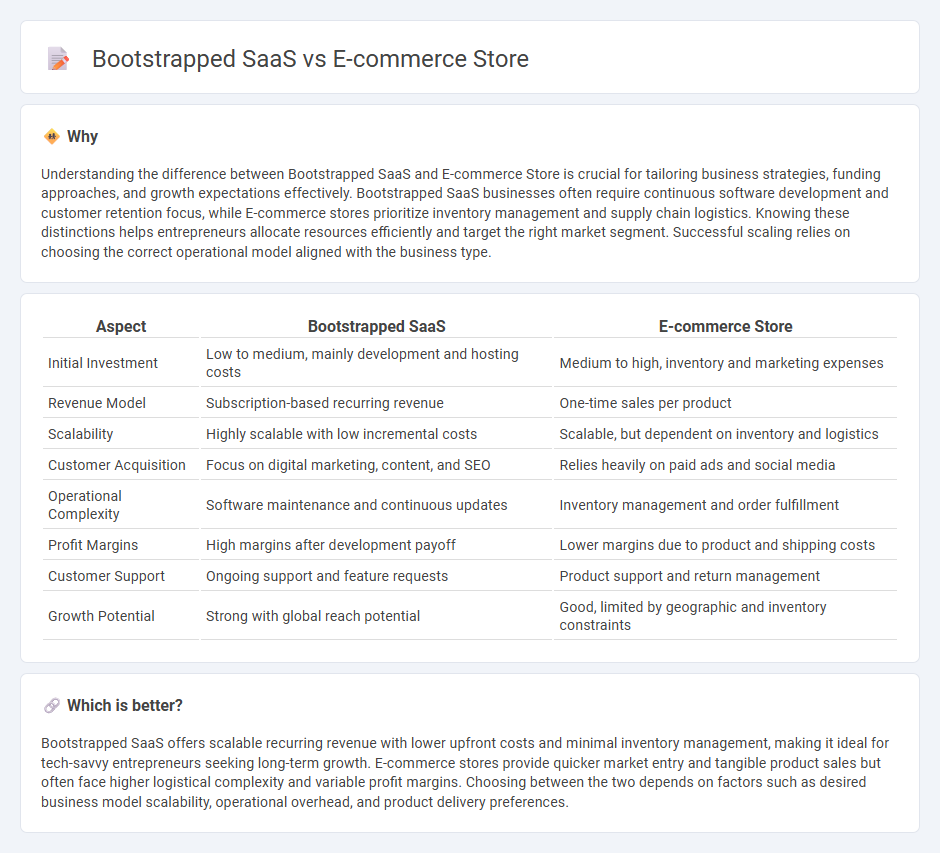
Bootstrapped SaaS ventures focus on developing scalable software solutions with minimal initial capital, emphasizing recurring revenue and product-market fit. E-commerce stores rely on inventory management, supplier relationships, and direct customer sales, often requiring more upfront investment in stock and marketing. Explore the key differences to determine which model aligns best with your entrepreneurial goals.
Why it is important
Understanding the difference between Bootstrapped SaaS and E-commerce Store is crucial for tailoring business strategies, funding approaches, and growth expectations effectively. Bootstrapped SaaS businesses often require continuous software development and customer retention focus, while E-commerce stores prioritize inventory management and supply chain logistics. Knowing these distinctions helps entrepreneurs allocate resources efficiently and target the right market segment. Successful scaling relies on choosing the correct operational model aligned with the business type.
Comparison Table
| Aspect | Bootstrapped SaaS | E-commerce Store |
|---|---|---|
| Initial Investment | Low to medium, mainly development and hosting costs | Medium to high, inventory and marketing expenses |
| Revenue Model | Subscription-based recurring revenue | One-time sales per product |
| Scalability | Highly scalable with low incremental costs | Scalable, but dependent on inventory and logistics |
| Customer Acquisition | Focus on digital marketing, content, and SEO | Relies heavily on paid ads and social media |
| Operational Complexity | Software maintenance and continuous updates | Inventory management and order fulfillment |
| Profit Margins | High margins after development payoff | Lower margins due to product and shipping costs |
| Customer Support | Ongoing support and feature requests | Product support and return management |
| Growth Potential | Strong with global reach potential | Good, limited by geographic and inventory constraints |
Which is better?
Bootstrapped SaaS offers scalable recurring revenue with lower upfront costs and minimal inventory management, making it ideal for tech-savvy entrepreneurs seeking long-term growth. E-commerce stores provide quicker market entry and tangible product sales but often face higher logistical complexity and variable profit margins. Choosing between the two depends on factors such as desired business model scalability, operational overhead, and product delivery preferences.
Connection
Bootstrapped SaaS and e-commerce stores share a strong connection through their reliance on lean startup principles, enabling entrepreneurs to launch and scale businesses with minimal external funding. Both models emphasize customer-centric product development, rapid iteration, and efficient cash flow management to sustain growth while maintaining control. Leveraging digital marketing, data analytics, and direct customer feedback further strengthens their ability to optimize operations and enhance user experience.
Key Terms
E-commerce Store:
E-commerce stores generate revenue through direct product sales, relying heavily on effective product sourcing, inventory management, and robust online marketing strategies such as SEO and social media campaigns. Unlike bootstrapped SaaS businesses that focus on subscription-based recurring revenue, e-commerce stores must optimize for high conversion rates and customer retention through seamless user experiences and streamlined checkout processes. Explore in-depth strategies to maximize your e-commerce store's profitability and growth potential.
Inventory Management
E-commerce stores require robust inventory management systems to track physical stock levels, manage suppliers, and handle warehouse logistics to prevent overselling or stockouts. Bootstrapped SaaS businesses focus on digital product management or service subscriptions, often bypassing tangible inventory concerns but prioritizing user data and software version control. Explore how tailored inventory strategies can optimize operational efficiency for both models.
Payment Gateway
E-commerce stores typically require a payment gateway that supports a wide range of transaction types, including credit card payments, digital wallets, and international currencies, ensuring seamless checkout experiences for diverse customers. Bootstrapped SaaS platforms emphasize integration with subscription billing and recurring payment processing, prioritizing secure API connections and customizable invoicing features. Discover the best payment gateway solutions tailored to your business model to optimize revenue flow and customer satisfaction.
Source and External Links
eCommerce Website Builder: Build An eCommerce Site - Wix offers a comprehensive all-in-one platform for creating customizable eCommerce websites with tools to manage products, payments, shipping, orders, and analytics, plus free hosting and scalable infrastructure for high-volume sales.
Build a Free Online Store or eCommerce Website - Square Online allows you to quickly create and customize a free eCommerce website with no coding needed, syncing online and offline sales, managing inventory and fulfillment, and integrating social media shopping features.
Shopify: The All-in-One Commerce Platform for Businesses - Shopify enables businesses of all sizes to build stylish, scalable online stores with multichannel selling, powerful checkout, in-person POS integration, and support for global and wholesale commerce.
 dowidth.com
dowidth.com